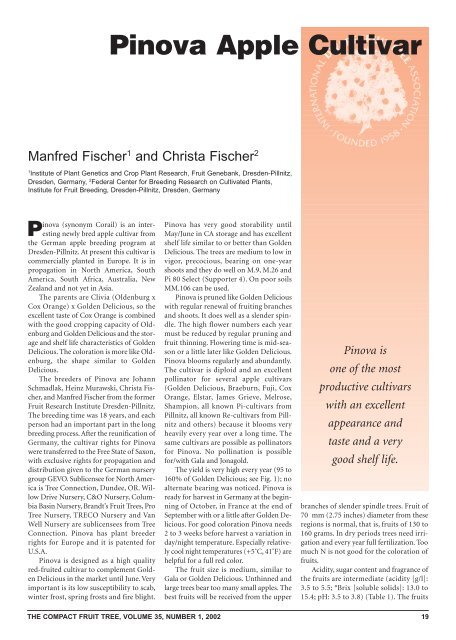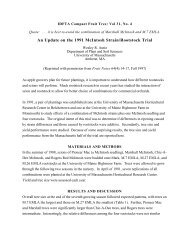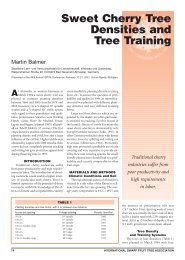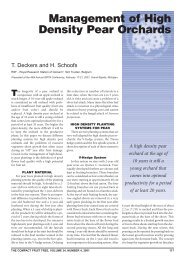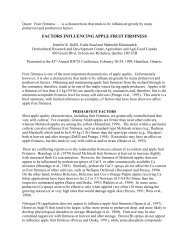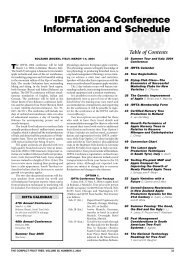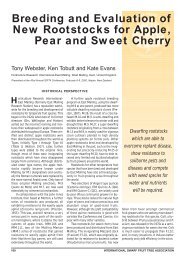Pinova Apple Cultivar - Virtual Orchard
Pinova Apple Cultivar - Virtual Orchard
Pinova Apple Cultivar - Virtual Orchard
You also want an ePaper? Increase the reach of your titles
YUMPU automatically turns print PDFs into web optimized ePapers that Google loves.
<strong>Pinova</strong> <strong>Apple</strong> <strong>Cultivar</strong><br />
Manfred Fischer 1 and Christa Fischer 2<br />
1<br />
Institute of Plant Genetics and Crop Plant Research, Fruit Genebank, Dresden-Pillnitz,<br />
Dresden, Germany, 2 Federal Center for Breeding Research on Cultivated Plants,<br />
Institute for Fruit Breeding, Dresden-Pillnitz, Dresden, Germany<br />
<strong>Pinova</strong> (synonym Corail) is an interesting<br />
newly bred apple cultivar from<br />
the German apple breeding program at<br />
Dresden-Pillnitz. At present this cultivar is<br />
commercially planted in Europe. It is in<br />
propagation in North America, South<br />
America, South Africa, Australia, New<br />
Zealand and not yet in Asia.<br />
The parents are Clivia (Oldenburg x<br />
Cox Orange) x Golden Delicious, so the<br />
excellent taste of Cox Orange is combined<br />
with the good cropping capacity of Oldenburg<br />
and Golden Delicious and the storage<br />
and shelf life characteristics of Golden<br />
Delicious. The coloration is more like Oldenburg,<br />
the shape similar to Golden<br />
Delicious.<br />
The breeders of <strong>Pinova</strong> are Johann<br />
Schmadlak, Heinz Murawski, Christa Fischer,<br />
and Manfred Fischer from the former<br />
Fruit Research Institute Dresden-Pillnitz.<br />
The breeding time was 18 years, and each<br />
person had an important part in the long<br />
breeding process. After the reunification of<br />
Germany, the cultivar rights for <strong>Pinova</strong><br />
were transferred to the Free State of Saxon,<br />
with exclusive rights for propagation and<br />
distribution given to the German nursery<br />
group GEVO. Sublicensee for North America<br />
is Tree Connection, Dundee, OR. Willow<br />
Drive Nursery, C&O Nursery, Columbia<br />
Basin Nursery, Brandt’s Fruit Trees, Pro<br />
Tree Nursery, TRECO Nursery and Van<br />
Well Nursery are sublicensees from Tree<br />
Connection. <strong>Pinova</strong> has plant breeder<br />
rights for Europe and it is patented for<br />
U.S.A.<br />
<strong>Pinova</strong> is designed as a high quality<br />
red-fruited cultivar to complement Golden<br />
Delicious in the market until June. Very<br />
important is its low susceptibility to scab,<br />
winter frost, spring frosts and fire blight.<br />
<strong>Pinova</strong> has very good storability until<br />
May/June in CA storage and has excellent<br />
shelf life similar to or better than Golden<br />
Delicious. The trees are medium to low in<br />
vigor, precocious, bearing on one-year<br />
shoots and they do well on M.9, M.26 and<br />
Pi 80 Select (Supporter 4). On poor soils<br />
MM.106 can be used.<br />
<strong>Pinova</strong> is pruned like Golden Delicious<br />
with regular renewal of fruiting branches<br />
and shoots. It does well as a slender spindle.<br />
The high flower numbers each year<br />
must be reduced by regular pruning and<br />
fruit thinning. Flowering time is mid-season<br />
or a little later like Golden Delicious.<br />
<strong>Pinova</strong> blooms regularly and abundantly.<br />
The cultivar is diploid and an excellent<br />
pollinator for several apple cultivars<br />
(Golden Delicious, Braeburn, Fuji, Cox<br />
Orange, Elstar, James Grieve, Melrose,<br />
Shampion, all known Pi-cultivars from<br />
Pillnitz, all known Re-cultivars from Pillnitz<br />
and others) because it blooms very<br />
heavily every year over a long time. The<br />
same cultivars are possible as pollinators<br />
for <strong>Pinova</strong>. No pollination is possible<br />
for/with Gala and Jonagold.<br />
The yield is very high every year (95 to<br />
160% of Golden Delicious; see Fig. 1); no<br />
alternate bearing was noticed. <strong>Pinova</strong> is<br />
ready for harvest in Germany at the beginning<br />
of October, in France at the end of<br />
September with or a little after Golden Delicious.<br />
For good coloration <strong>Pinova</strong> needs<br />
2 to 3 weeks before harvest a variation in<br />
day/night temperature. Especially relatively<br />
cool night temperatures (+5˚C, 41˚F) are<br />
helpful for a full red color.<br />
The fruit size is medium, similar to<br />
Gala or Golden Delicious. Unthinned and<br />
large trees bear too many small apples. The<br />
best fruits will be received from the upper<br />
<strong>Pinova</strong> is<br />
one of the most<br />
productive cultivars<br />
with an excellent<br />
appearance and<br />
taste and a very<br />
good shelf life.<br />
branches of slender spindle trees. Fruit of<br />
70 mm (2.75 inches) diameter from these<br />
regions is normal, that is, fruits of 130 to<br />
160 grams. In dry periods trees need irrigation<br />
and every year full fertilization. Too<br />
much N is not good for the coloration of<br />
fruits.<br />
Acidity, sugar content and fragrance of<br />
the fruits are intermediate (acidity [g/l]:<br />
3.5 to 5.5; °Brix [soluble solids]: 13.0 to<br />
15.4; pH: 3.5 to 3.8) (Table 1). The fruits<br />
THE COMPACT FRUIT TREE, VOLUME 35, NUMBER 1, 2002 19
are firm to very firm and good for shipping<br />
(penetrometer kg/cm 2 : 9.5 [harvest] to 6.5<br />
[end of storage]; for comparison Florina:<br />
8.3 to 4.8, Idared: 8.3 to 4.5). The vitamin<br />
C content of <strong>Pinova</strong> is not high.<br />
<strong>Pinova</strong> is not from the resistance<br />
breeding program. However, it is a robust<br />
cultivar without special problems of plant<br />
FIGURE 1<br />
protection: the susceptibility to scab is low,<br />
to mildew is medium (mildew on the fruits<br />
brings a little russeting), to fire blight is<br />
low to medium (like Golden Delicious and<br />
better). Its tendency for second blooming<br />
is not a problem for increased fire blight<br />
infection. This phenomenon was tested in<br />
the field after strong artificial infection.<br />
Productivity of the Pillnitz apple cultivars. Data are kg/tree, averaged for 10 years, relative to Golden<br />
Delicious (=100), with rootstocks M.9 and M.26 at Pillnitz.<br />
Golden Delicious<br />
Idared<br />
Piros<br />
Pia<br />
Pirol<br />
Piflora<br />
<strong>Pinova</strong><br />
Pingo<br />
Pilot<br />
72<br />
76<br />
0 20 40 60 80 100 120 140<br />
% (Golden Delicious=100)<br />
95<br />
96<br />
100<br />
106<br />
115<br />
124<br />
130<br />
Phytophthora and canker we have not observed<br />
yet. Bitter pit is seldom seen. Under<br />
extremely warm conditions sunburn on<br />
the south side of the fruits is possible. In<br />
Germany it was helpful in some years to<br />
spray before storage against Gloeosporium<br />
rot. Winter frost to -25˚C (-13˚F) has not<br />
been a problem under German and Polish<br />
conditions.<br />
For good fruit size and quality fruit,<br />
thinning is important. It is possible to thin<br />
by hand and with chemicals. Before thinning<br />
an exact evaluation of the yearly<br />
blooming capacity is needed. Thinning is<br />
possible from the full pink stage of flowers<br />
up to fruit diameter of 20 mm. The best<br />
results are obtained if chemical thinning<br />
is followed by hand thinning.<br />
Storage is best at 1˚C (33.8˚F). Optimum<br />
conditions for CA storage are 2.5%<br />
CO 2 , 1.3% O 2 , and 1.3˚C (34.3˚F). <strong>Pinova</strong><br />
can be stored for 240 days without problems.<br />
At the end of storage the fruits have<br />
a firmness of 5.0 to 6.0 kg/cm 2 .<br />
We conclude that <strong>Pinova</strong> is one of the<br />
most productive cultivars with an excellent<br />
appearance and taste and a very good shelf<br />
life for the fresh market. The management<br />
is easy with slender spindle if pruning and<br />
thinning occur every year. It can grow in all<br />
regions without extreme temperatures. In<br />
dry regions it needs irrigation. Phytosanitary<br />
problems are small. The storability is<br />
excellent.<br />
TABLE 1<br />
Content of soluble solids (%), acidity (g/l) and Vitamin C (in brackets; mg/100 g) in various apple cultivars at eating maturity.<br />
Acidity (g/l)<br />
Soluble<br />
solids (%) 0.3 0.4 0.5 0.6 0.7 0.8 0.9 1.0 1.2 1.3<br />
18 Rubinette<br />
(4.0)<br />
17 Jonagold Delbard Boskoop<br />
(3.8) Jubilé (7.7) (6.0)<br />
16 Rubinola Pilot (21.9) Cox Orange<br />
(7.7) (13.6)<br />
15 Regine Reanda (3.9) Remo (3.0)<br />
(10.5) Pingo (18.3)<br />
14 Liberty GD (2.1) Releika Piros (1.0) Ecolette Rebella<br />
(2.0) <strong>Pinova</strong> (11.7) Otava (1.5) (10.5) (7.7)<br />
Priscilla (2.7) Retina Renora (2.7)<br />
(5.8) (1.0) Relinda (4.4)<br />
Piflora (2.7)<br />
13 Delorina Elstar (4.1) Pia (1.1) Topaz (5.1) Rewena<br />
(1.8) Gloster (1.2) (3.5)<br />
Florina Reglindis<br />
(4.1) (1.5)<br />
Freedom Resi (1.2)<br />
(0.9)<br />
Jonafree<br />
(12.0)<br />
12 Gala (1.1)<br />
11 Idared (5.5)<br />
Hana (1.1)<br />
20 INTERNATIONAL DWARF FRUIT TREE ASSOCIATION


